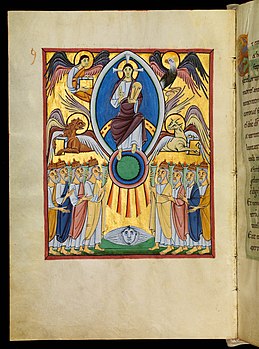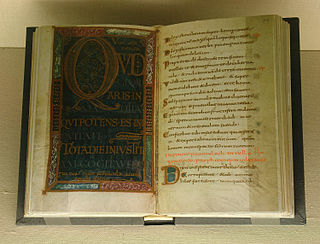
The Vulgate is a late-4th-century Latin translation of the Bible that became the Catholic Church's officially promulgated Latin version of the Bible during the 16th century. The translation was largely the work of Jerome, who in 382 had been commissioned by Pope Damasus I to revise the Vetus Latina Gospels then in use by the Roman Church. Jerome, on his own initiative, extended this work of revision and translation to include most of the books of the Bible, and once published, the new version was widely adopted and eventually eclipsed the Vetus Latina; so that by the 13th century, it had taken over from the former version the appellation of versio vulgata or vulgata for short, and in Greek as βουλγάτα ("Voulgata").

The FirstBible of Charles the Bald is a Carolingian-era Bible commissioned by Count Vivien in 845, the lay abbot of Saint-Martin de Tours, and presented to Charles the Bald in 846 on a visit to the church, as shown in the presentation miniature at the end of the book. It is also known as the Count Vivian Bible or the Vivian Bible. It is 495 mm by 345 mm and has 423 vellum folia.

The Old English Bible translations are the partial translations of the Bible prepared in medieval England into the Old English language. The translations are from Latin texts, not the original languages.

A metrical psalter is a kind of Bible translation: a book containing a metrical translation of all or part of the Book of Psalms in vernacular poetry, meant to be sung as hymns in a church. Some metrical psalters include melodies or even harmonizations. The composition of metrical psalters was a large enterprise of the Protestant Reformation, especially in its Calvinist manifestation.

Hexapla is the term for a critical edition of the Hebrew Bible in six versions, four of them translated into Greek, preserved only in fragments. It was an immense and complex word-for-word comparison of the original Hebrew Scriptures with the Greek Septuagint translation and with other Greek translations. The term especially and generally applies to the edition of the Old Testament compiled by the theologian and scholar Origen, sometime before the year 240 CE.

The Bamberg Apocalypse is an 11th-century richly illuminated manuscript containing the Book of Revelation and a Gospel Lectionary.

The Luttrell Psalter is an illuminated psalter commissioned by Sir Geoffrey Luttrell (1276–1345), lord of the manor of Irnham in Lincolnshire, written and illustrated on parchment circa 1320–1340 in England by anonymous scribes and artists.

The Utrecht Psalter is a ninth-century illuminated psalter which is a key masterpiece of Carolingian art; it is probably the most valuable manuscript in the Netherlands. It is famous for its 166 lively pen illustrations, with one accompanying each psalm and the other texts in the manuscript. The precise purpose of these illustrations, and the extent of their dependence on earlier models, have been matters of art historical controversy. The psalter spent the period between about 1000 to 1640 in England, where it had a profound influence on Anglo-Saxon art, giving rise to what is known as the "Utrecht style". It was copied at least three times in the Middle Ages. A complete facsimile edition of the psalter was made in 1875, and another in 1984 (Graz).

The Parker Library is the rare books and manuscripts library of Corpus Christi College, Cambridge. It is known throughout the world due to its invaluable collection of over 600 manuscripts, particularly medieval texts, the majority of which were bequeathed to the College by Archbishop of Canterbury Matthew Parker, a former Master of Corpus Christi College.

The Psalter of Oswald also called the Ramsey Psalter is an Anglo-Saxon illuminated psalter of the last quarter of the tenth century. Its script and decoration suggest that it was made at Winchester, but certain liturgical features have suggested that it was intended for use at the Benedictine monastery of Ramsey Abbey, or for the personal use of Ramsey's founder St Oswald.

The Eadwine Psalter or Eadwin Psalter is a heavily illuminated 12th-century psalter named after the scribe Eadwine, a monk of Christ Church, Canterbury, who was perhaps the "project manager" for the large and exceptional book. The manuscript belongs to Trinity College, Cambridge and is kept in the Wren Library. It contains the Book of Psalms in three languages: three versions in Latin, with Old English & Anglo-Norman translations, and has been called the most ambitious manuscript produced in England in the twelfth century. As far as the images are concerned, most of the book is an adapted copy, using a more contemporary style, of the Carolingian Utrecht Psalter, which was at Canterbury for a period in the Middle Ages. There is also a very famous full-page miniature showing Eadwine at work, which is highly unusual and possibly a self-portrait.

The Munich Serbian Psalter is a 14th-century illuminated psalter written in Church Slavonic of the Serbian recension. With its 229 leaves illustrated with 148 miniatures, it is regarded as the most extensively illuminated Serbian manuscript book. It was written after 1370 in Moravian Serbia, either for its ruler Prince Lazar, or more likely, for his successor Stefan Lazarević. The book was rebound in 1630 by Serbian Patriarch Pajsije. It was taken to Bavaria in the late 17th century, and has been kept in the Bavarian State Library in Munich since the beginning of the 19th century.
The Oxford Serbian Psalter is a manuscript psalter written on parchment in the late 14th century in Church Slavonic of the Serbian recension. It is well preserved, missing only one leaf, which contained Psalm 118:108–21, and now it has 219 leaves. Practically devoid of illuminations, it is written "in a hand which is clear and careful but not elegant".

The Seeon Evangeliary or Evangeliary of Henry II is an evangeliary created at Seeon Abbey between 1002 and 1014. Today it is kept in the Bamberg State Library under the record number Msc. Bibl. 95)

The Stuttgart Psalter is a richly illuminated 9th-century psalter, considered one of the most significant of the Carolingian period. Written in Carolingian minuscule, it contains 316 images illustrating the Book of Psalms according to the Gallican Rite. It has been archived since the late 18th century at the Württembergische Landesbibliothek in Stuttgart.
The Great Psalms Scroll, also referred to as 11Q5, is the most substantial and well preserved Dead Sea Scrolls Psalms manuscript of the thirty-seven discovered in the Qumran caves, six of which were discovered in Cave 11.
The Oxford Psalter is a 12th century Psalter written in Anglo-Norman Old French. Its content is almost identical to that of the Winchester Psalter, except the latter is written in Latin and Anglo-Norman Old French. In his book Libri Psalmorum versio antiqua Gallica e cod. ms. in Bibl. Bodleiana, Francisque Michel does a full transcription of the Psalter, writing the Winchester Psalter variants in the footnotes under the header Cott. Cod..
















